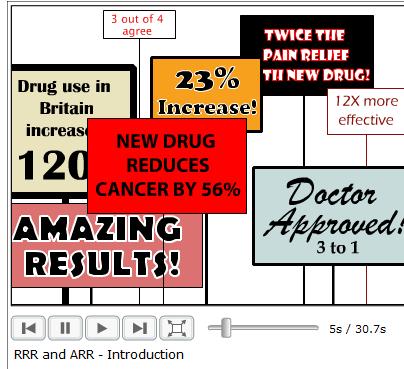
Data on risk reduction derived from trials can be expressed in different ways. Too often the results of prevention trials are presented in ways that exaggerate the benefits of an intervention, and information is withheld that would allow us to more realistically understand the degree to which risk is reduced.
The most common way in which results are presented in order to throw a more favourable light than is warranted is to only present the reductions in relative risk, and to withhold information on absolute risk reduction.
In iPrEx for example we were told that the relative risk reduction in people taking Truvada was 44%.
But what does a 44% reduction in relative risk mean? Certainly not a 56% risk of infection without PrEP, as several people have said when asked this question. It’s because of these answers that I’m writing this.
Relative risk reduction tells you the percent reduction in risk in the treated group compared to that in the control group, or how much lower the risk with an intervention is relative to the starting risk.
If you are not clearly told what the risk is to begin with, then you can’t tell what the actual reduction of risk is when taking the intervention; all you know is how much lower it is than a number that is not clearly presented to you.
Although it is not clearly stated in the published trial report, we can work out what the starting chance of infection is.
It’s the number of infections occurring in the placebo group during the time period of the study. We were told that 64 out of 1248 people in the placebo group were infected, which is 5.1 in 100, or 0.051 in 1. (Since then there have been additional infections, reported at the recent conference in Rome, reflecting an increase in the number of infections over a longer time period).
The absolute risk reduction, as opposed to the relative risk reduction conferred by Truvada tells you how much lower the risk is than in the placebo group in absolute terms.
2.8% of the 1251 people in the Truvada arm became infected compared to 5.1% in the placebo group.
The reduction of risk in the Truvada group is therefore 5.1 minus 2.8, which is 2.3.
Truvada PrEP reduces the absolute risk of infection by 2.3%.
A 2.3 % reduction in absolute risk is nowhere nearly as impressive as a 44% reduction in relative risk.
Yet this lower number is a more accurate measure of the efficacy of Truvada PrEP. (1)
The actual risk of infection in the Truvada arm was 2.8%, which surely is a figure that is more useful to an individual considering PrEP. (2)
Not clearly stating the absolute risk reduction conferred by Truvada was unfortunate. I haven’t checked, but will look to be sure that absolute risk reductions were clearly stated in the other recent PrEP trial reports.
Maybe in Rome, the absolute risk reduction conferred by Truvada was in fact clearly stated.
Knowing the absolute risk reduction allows one to calculate another important measure, which again I did not notice in the trial report.
This is the number of people who need to be treated (NNT) in order to prevent one infection. From the information presented it appears that about 45 people need to be treated in order to prevent a single infection. NNT is a useful number as it allows one to estimate what it would cost to prevent a single infection with Truvada.
The cost of the drug is the least of it. A person taking Truvada needs to be monitored at regular intervals for toxicity and importantly, for infection, in order to prevent the inevitable emergence of resistant viruses as a result of sub optimal treatment.
It should be possible to make a ball park estimate of what it will cost to prevent one infection. Whatever it is, it’s the cost of treating and monitoring 44 people who will derive no benefit and be subjected to the adverse effects of tenofovir on their kidneys as well as other adverse effects. There will be additional costs if they generate resistant virus.
There is a great deal of information written to inform people about the differences between relative and absolute risk and how risk data can be manipulated to make the results appear to be better or worse than they really are.
I would recommend “Know Your Chances” by Steven Woloshin and others . The book opens with this statement.
Numbers can make people sick.
But they don’t have to.
Learn how to make them help you.
Or just put “absolute and relative risk” into the google search box.
(1)
I have copied this from a website in the UK addressed to patients:
Helping to decide about taking a treatment
The decision on whether to take a treatment needs to balance various things such as:
- What is the absolute risk of getting the disease to start with.
- How serious is the disease anyway.
- How much is the absolute risk reduced with treatment.
- The risks or side-effects in taking the treatment.
- How much does the treatment cost - is it worth it to an individual if the individual is paying, or is it worth it to the country if the government is paying?
To which must be added:
- More effective, cheaper and safer interventions are readily available (at least in developed countriers)
(2)
Unfortunately even knowing absolute risk and absolute risk reduction is still of limited help.
In anal intercourse the risks of infection to receptive and insertive partners are not equal. The receptive partner is at greatest risk, and may well be responsible for the bulk of the overall 2.8% risk of infection in the published report. It’s probably impossible to reliably break down the risks in the trial according to self-reported sexual act.
The investigators were easily able to discern the unreliability of self-reports on drug adherence. I don’t know why they were so willing to trust the reliability of self-reports about specific sexual acts.. Unlike verifying adherence reports by measuring drug levels, there is no way to verify self-reports of unprotected receptive anal intercourse. Self-reported sexual practices in epidemiological investigations have been repeatedly proven to be unreliable in several studies.
Given that the receptive partner is at greater risk, their best protection is of course to refuse sex with a partner who will not use a condom. Among men who have sex with men there surely can only be very limited situations when the receptive partner would choose the more dangerous course. For example, in a relationship where the insertive partner cannot maintain an erection with a condom, or where a couple feels that intimacy is diminished with a condom. We should be supportive of PrEP in these circumstances We should also make clear what we know about risk, and provide more information than simply relative risk reduction numbers.







5 Comments
5 Comments